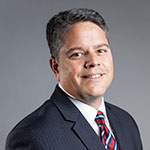The Hispanic Professionals of Greater Milwaukee (HPGM) organization has been around since 2001, but over the past three years, growth has been robust. Infrastructure has improved, membership has increased, and headquarters has relocated to Milwaukee’s downtown area to be near its key constituents. Today, HPGM represents not only Latinos working in corporate America, but also college students, offering programs to both demographics to either continue an education or jump-start a career from entry- to senior-level, up until retirement. It was the vision of president and CEO Griselda Aldrete to revamp HPGM into what it is today. She chats with HE about what it takes to restructure an organization and her passion for wrenching open the pipeline to Latino success.
Now that you’re in the final phases of a successful restructure, looking back, what was HPGM lacking before?
When I began at HPGM in 2012, it was a two-person staff tasked with doing 150 things. That’s hard to do when you’re trying to grow and have an impact.
The other issue was our location. From 2007 to November 2014, we were located at the Spanish Center, which is a social service organization on the south side of Milwaukee which also houses other nonprofits. Because of that, we were often confused with other social service agencies. I felt it was important for our Latino professional and business membership organization to move to a more business-central neighborhood. Moving to downtown was a very intentional move. I wanted us to have our own identity, and the move helped change the way people looked at us.
HPGM’s scope has broadened. Who does the organization represent currently?
Our key membership includes students, professionals, and corporate members. Today we have approximately 1,400 members total, with about 575 of those being students. We are partnered with about fifty-seven corporations regionally in the state.
What is HPGM’s goal under your presidency?
Our goal in Wisconsin is to change the outlook of Latinos in general. Latinos in the country are growing at a fast rate, and Wisconsin is not an exception. Historically, Milwaukee is a segregated city, and race relations have been strained for many years, so our organization is making an effort to change the perception of the Latino in our region. We want people to know that Latinos are a force to be reckoned with because they are educated and smart, and we are removing any barrier that would hinder success.
What was your strategy to reach that goal?
2012 was really our year to step back, take a hard look at HPGM, and do a lot of organizational assessment. We became very focused and strategic. When I was hired I didn’t want to just manage a social organization. I wanted us to really think about what we wanted to stand for, what programs we wanted to be known for, and where we saw ourselves in the future. As an organization, we said, “Have we been successful? If yes, well, how do we measure success?”
We surveyed our corporate members and members who have been around since the beginning to really find out what they liked about the organization, what they felt was lacking, and then how to move forward.
A very strategic plan to answer the question about pipelining Latino talent was implanted in the fall of 2012 when we actually began working with universities. We had never worked with students before. We asked some of the largest universities in the state what they are doing to help attract, retain, and recruit Hispanics and get them to persist at the college level. That was the beginning of the programming we developed for our students today.
“I wanted us to really think about what we wanted to stand for, what programs we wanted to be known for, and where we saw ourselves in the future.”
Give us an overview of some of the programs offered to both students and professional members.
With our students, we have a four-pronged model, which is tiered depending on their school year. We track the academic success of our student members and provide financial literacy assistance. We help them understand loans and financial aid and what those will mean upon graduation. We also work on their online presence because we know that’s where this generation sort of lives, and we know corporations look at that to ensure that they’re hiring mature individuals regardless of age.
We also have a mentorship program where our professional members mentor the student members and then we pipeline students in with internships. Our goal is for each student to have at least completed two internships before graduation.
For young professionals, we developed a program where we teach skill sets necessary to move into mid-career. For our mid-career members, we just launched a program centered on affinity groups or employee resource groups. This is really to engage a different demographic of our membership to make sure that from a company standpoint we’re giving them an investment because we know affinity groups have been a huge topic of interest for corporations. Eventually, we would like to be able to offer C-suite executives an avenue to pipeline them into private, corporate, or government boards.
What has been the biggest game-changer in HPGM’s makeover?
Part of my strategy was growing our revenue to grow our infrastructure and team. April 2014 was the first HPGM Five Star Gala, and we raised about $300,000. With the new budget, we now have four full-time staff members, we added a second round of co-chairs, and expanded our reach to the programs for student chapters. We then had our second annual gala on May 9th, 2015, raising over $300,000, surpassing our fundraising goal. These funds will help launch our undergraduate scholarship program for 2016.
How has working for HPGM translated your passion into a career?
I became a professional member in 2007 after reporting for ¡Aquí! Milwaukee and interviewing HPGM’s first hired executive director. Later in 2011, HPGM opened the position, and I interviewed for it, but my first job offer was as program manager. I could see the potential that HPGM had, and my vision was to make it grow. I’ve now been with the organization for three years and have moved up from manager to executive director to now CEO.
HPGM has helped me focus on my passion. I’m extremely invested in the success of Latinos, and I think education continues to be the universal equalizer for people. I’m a first-generation college student. My dad is a Mexican immigrant and my mom is from El Salvador, and they always told my sister and me that education would be the key to our success.
Post-makeover, what are you most excited about?
I’m really excited about inspiring the next wave of Latino leaders, but most importantly, HPGM’s success is not just correlated with me. It’s my team and my board of directors who give me guidance and are my ambassadors in the wider community and in the corporate community.

